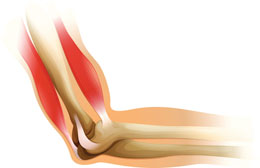Olecranon is the bony point of the elbow that you can feel beneath the skin. It is covered by a thin layer of tissue, which is why, it is susceptible to fractures. The following Buzzle write-up provides information on olecranon fractures.

The elbow joint is a hinge joint that is made of bones called the humerus, radius, and ulna. It helps us rotate the forearm. The
distal humerus makes the hinge in the center of the elbow, and the
radial head moves around on the distal humerus. This bone also moves when you turn your wrist up and down. The
olecranon cups the end of the humerus bone. The olecranon rotates at the end of the humerus like a hinge. It is the bony prominence which extends from the ulna (forearm bone located between the elbow and the wrist). It can be felt under the skin of the elbow. It is prone to fractures, as it is not protected by muscles and soft tissues, and is covered by a thin layer of tissue only.
Causes
Olecranon fractures are observed only in about 4 - 7% of children. This kind of fracture might occur when the child falls on his/her outstretched hand. In rare cases, it might occur due to direct trauma.
Direct Blow
A person can suffer from this type of fracture due to a fall that causes him/her to land on his elbow directly. It can occur when one is struck with a baseball bat. It might occur if one hits the dashboard of a car in an accident.
Indirect Blow
Olecranon stress fractures are commonly seen in baseball pitchers. These can occur when one lands on an outstretched arm, with the elbow locked out straight.
Types
These fractures are categorized into non-displaced and the displaced fractures. In case of the former, the bone is not displaced. This includes crushing, transverse, or oblique fractures. The bone is separated about 2 mm below the elbow when observed on an X-ray. In case of the latter, there's a displacement of more than 3 mm, and there is no stretch of the elbow against gravity activities. Displaced fractures are divided into different types as follows:
Olecranon Avulsion Fracture
This involves a small block fracture with horizontal shape.
Transverse Fracture
This is a fracture where the line of fracture is oblique.
Comminuted Fracture
This is caused by direct external force like getting struck with a baseball bat. It may also involve soft tissue injury in some cases.
Combined Elbow Fracture
In this type of fracture, there is dislocation of the elbow, and the fracture line is oblique.
Symptoms
- Pain, swelling, deformity, and bruising of the elbow might be observed.
- The person is unable to extend the elbow.
- The elbow is tender to touch.
- Numbness in one or more fingers might be experienced in some cases.
- Joint movement might give rise to pain.
Treatment
The treatment would be determined by the amount of displacement. In case of minimum or non-displaced fracture, no surgery is required. In such cases, splints are considered. These splints provide support, and also help reduce pain and swelling. Immobilization also helps the soft tissues and bone to heal.
Surgery is carried out when the bone is dislocated, or in case the triceps are detached. During the surgery, the doctor tries to reposition the bones and attach the triceps.
The recovery period depends on the severity of the fracture and the length of time taken by the bones to repair themselves. Physiotherapy sessions would be required for regaining the normal range of motion of the joint. Timely diagnosis and treatment is required to avoid complications such as loss of movement of the elbow joint, non-union of the bones, or arthritis of the elbow joint.
Disclaimer:
The information provided in this article is solely for educating the reader. It is not intended to be a substitute for the advice of a medical expert.


 The elbow joint is a hinge joint that is made of bones called the humerus, radius, and ulna. It helps us rotate the forearm. The distal humerus makes the hinge in the center of the elbow, and the radial head moves around on the distal humerus. This bone also moves when you turn your wrist up and down. The olecranon cups the end of the humerus bone. The olecranon rotates at the end of the humerus like a hinge. It is the bony prominence which extends from the ulna (forearm bone located between the elbow and the wrist). It can be felt under the skin of the elbow. It is prone to fractures, as it is not protected by muscles and soft tissues, and is covered by a thin layer of tissue only.
The elbow joint is a hinge joint that is made of bones called the humerus, radius, and ulna. It helps us rotate the forearm. The distal humerus makes the hinge in the center of the elbow, and the radial head moves around on the distal humerus. This bone also moves when you turn your wrist up and down. The olecranon cups the end of the humerus bone. The olecranon rotates at the end of the humerus like a hinge. It is the bony prominence which extends from the ulna (forearm bone located between the elbow and the wrist). It can be felt under the skin of the elbow. It is prone to fractures, as it is not protected by muscles and soft tissues, and is covered by a thin layer of tissue only.